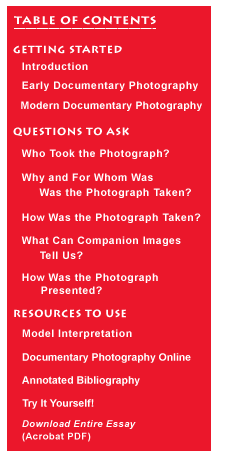talking history | syllabi | students | teachers | puzzle | about us

|
 |
|
Two urban photographers, Jacob Riis and Lewis Hine, took up the effort to explore the “wilderness” of the inner city and thereby establish documentary photography as a tool of social reform. Riis, a Danish immigrant and police reporter for the New York Tribune, continues to be revered for his late nineteenth-century expose of tenement conditions in New York’s Lower East Side and Lewis Hine has won lasting fame as a pictorial champion of working men and women and as a crusader against child labor during the progressive period. Riis and Hine shocked their contemporaries with dramatic images showing the human consequences of unchecked urban growth and industrial excess. Previous to their work, photos of the city celebrated urban architecture or provided perspectives that emphasized the city’s bustle, traffic, and commerce. Moreover, by the last decade of the nineteenth century, new processes (especially the “halftone”) allowed photographs to be inexpensively reproduced in newspapers, magazines, and books. This technological development vastly increased the dissemination of documentary images. Before the turn of the twentieth century, pictures of working and poor people were limited to portraits taken in photographic studios. The sensational impact of Riis’s and Hine’s photos was no accidental by-product, but rather the very essence of their photographic fieldwork. Heir in many ways to the work of Riis and Hine, the Farm Security Administration Photographic Project (1935-1942) quickly surpassed the combined output of these two pioneers and is now recognized as the most famous of America’s documentary projects. Beginning under the auspices of the Resettlement Administration in 1935 and then the Farm Security Administration (FSA) in 1937, a group that over time included about twenty men and women worked under the supervision of Roy E. Stryker to create a pictorial record of the impact of the Great Depression on the nation, primarily on rural Americans. This project, as photography historian Alan Trachtenberg has noted, “was perhaps the greatest collective effort . . . in the history of photography to mobilize resources to create a cumulative picture of a place and time.” Many of the eighty thousand photographs taken by the so-called FSA photographers were distributed by the agency to newspapers and magazines to build support for the rural programs of Franklin Delano Roosevelt’s New Deal. As FSA photographer Arthur Rothstein later recalled, “It was our job to document the problems of the Depression so that we could justify the New Deal legislation that was designed to alleviate them.” FSA photographers criss-crossed the country documenting the plight of Dust Bowl refugees, southern sharecroppers, migrant agricultural workers, and finally Japanese Americans bound for internment camps in the aftermath of Pearl Harbor. The FSA’s vast pictorial undertaking, as Stryker later recalled, endeavored to introduce “Americans to America.” This goal had a specific audience in mind: middle-class Americans who lived in cities far from the locales depicted in the photographs and who comprised the vast majority of the readers of the newspapers and magazines in which the FSA pictures were reproduced. For students of American culture, the FSA collection, now housed in the Library of Congress (and available online as part of the Library’s American Memory initiative) offers an unparalleled opportunity to use photographs as primary historical evidence. |
|

|
|
